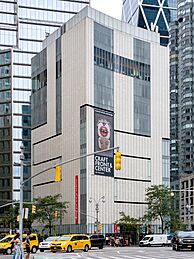Museum of Arts and Design facts for kids
 |
|
| Established | 1956 |
|---|---|
| Location | 2 Columbus Circle Manhattan, New York City |
| Type | Art museum |
| Public transit access | Bus: M5, M7, M2, M31, M57, M104 Subway: |
The Museum of Arts and Design (often called MAD) is a cool museum in Manhattan, New York City. It collects and shows amazing objects that highlight new and old ideas in craft, art, and design. Through its exhibits and learning programs, the museum celebrates how artists use different materials to create beautiful things that make our lives better.
Contents
The Museum's Story: How MAD Began
The museum first opened in 1956. Back then, it was called the Museum of Contemporary Crafts. Its main goal was to celebrate the amazing skills of modern American artists. A kind person named Aileen Osborn Webb, who loved crafts, helped the museum grow.
The museum put on shows that focused on the different materials and methods used in crafts. From the very beginning, it showed how craftsmanship was changing in society. It also helped new artists get noticed and connected art with industries.
Growing and Changing Names
From 1963 to 1987, Paul J. Smith was the museum's director. During his time, the museum had exciting and often interactive exhibits. These shows reflected what was happening in society. They also showed that all kinds of art, even everyday objects, could be celebrated.
In 1979, the museum moved to a bigger spot at 44 West 53rd Street and reopened as the American Craft Museum. To fit all its growing programs, the museum moved again in 1986. It found a new 18,000-square-foot home at 40 West 53rd Street. It stayed there until 2008.
Becoming the Museum of Arts and Design
The next ten years were a time of fast growth and many changes. The American Craft Council was reorganized, and the museum became its own separate organization. Holly Hotchner became the museum's director in 1996 and led it for 16 years.
Holly Hotchner started a big plan to make the museum even better. She added more people to the Board of Trustees and hired more experts to plan exhibits. This plan led to the museum changing its name in 2002 to the Museum of Arts and Design. This new name showed that the museum was collecting and showing many different types of art and design.
Because MAD's collections, public programs, and visitors kept growing, it won a bid in 2002. This allowed the museum to get the building at 2 Columbus Circle.
Moving to Columbus Circle
The museum's move to its new home at 2 Columbus Circle in 2008 caused a lot of discussion. The plans to change the building, which was originally designed by Edward Durell Stone, started a big debate about preserving old buildings. Many famous people, including writers and artists, joined the discussion. Congresswoman Carolyn B. Maloney even called it "one of New York's most photographed and readily recognizable buildings."
The new building was designed by Brad Cloepfil of Allied Works Architecture. It opened in September 2008. The building's outside walls are made of textured terra-cotta tiles and special glass. This design shows off MAD's history of crafts and its permanent collections.
Leadership Changes
From 2013 to 2021, MAD had several directors, including some who served temporarily. This was a lot of changes in leadership compared to other museums. In September 2013, Dr. Glenn Adamson became the new director. He had been a critic of the museum before, so his appointment was seen as a "bold choice." He stepped down after just over two years.
The next permanent director was Jorge Daniel Veneciano, who started in August 2016 but resigned after only five months. Chris Scoates became director in March 2018 and stepped down in August 2020. Timothy R. Rodgers became MAD's director in 2021.
The 2 Columbus Circle Building
The new location at 2 Columbus Circle is much bigger, with over 54,000 square feet. This is more than three times the size of the museum's old space!
The building has four floors of galleries where you can see works by both famous and new artists. There's also a 150-seat auditorium for talks, movies, and performances. You can even find a restaurant there.
The museum also has a special Center for the Study of Jewelry. Plus, there's an Education Center with multimedia tools for learning, hands-on classrooms for students, and three studios where artists can work.
See also
- List of design museums
- American craft
- Paul J. Smith (arts administrator), Director emeritus
- Lowery Stokes Sims, Curator emerita
- Ursula Ilse-Neuman, Curator emerita
- Shannon R. Stratton, former William and Mildred Lasdon Chief Curator



